Deep beneath the lush jungles of the Yucatan Peninsula, lies a hidden world that has captivated adventurers and divers alike.
With over 6,000 cenotes scattered throughout the region, it’s no wonder that the Mayan underworld holds the title of the largest underwater cave system in the world.
As sunlight pierces through the crystal-clear waters, revealing an intricate maze of submerged tunnels and chambers, one can’t help but be drawn into the enchantment of this mystical realm.
But beyond the allure lies a fascinating story waiting to be unraveled, one that intertwines history, culture, and the thrill of exploration.
So, come along and discover the secrets of diving in cenotes – a journey that will take you to the heart of the Mayan civilization and leave you yearning for more.
This experience made our list of the 13 Best Scuba Diving Experiences In Cancun.
Good To Know

- Cenotes are natural sinkholes in the Yucatan Peninsula, Mexico, with a rich history and importance in Mayan culture.
- Cenotes are formed through the collapse of limestone bedrock, revealing underground chambers filled with crystal-clear water and stunning geological formations.
- Cenotes were vital sources of freshwater for the Mayans and were considered sacred places for rituals and ceremonies.
- Diving in cenotes requires specialized equipment, safety precautions, and good buoyancy control, and the Mayan Riviera offers a diver’s paradise with numerous cenotes to explore.
History of Cenotes
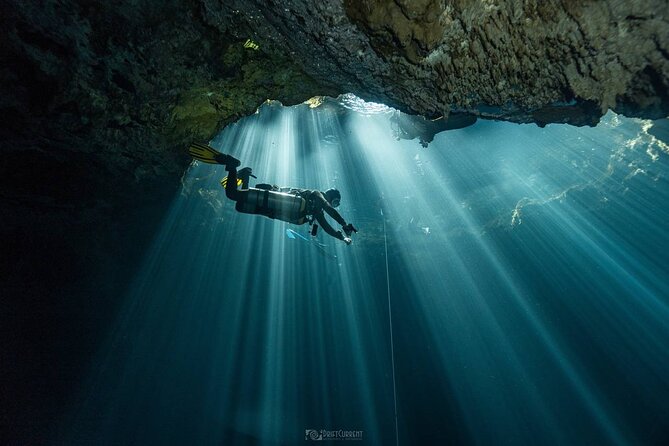
The history of cenotes, natural sinkholes found in the Yucatan Peninsula of Mexico, is a fascinating tale of geological wonder and ancient significance. These unique formations have been an integral part of the region’s ecosystem for millions of years.
Cenotes play a vital role in maintaining the delicate balance of the surrounding environment. They serve as a source of freshwater for both humans and wildlife, and their crystal-clear waters support diverse ecosystems, teeming with life.
Over time, the Mayans recognized the importance of cenotes and incorporated them into their religious practices. They believed that these sinkholes were sacred portals to the underworld and often used them for rituals and sacrifices.
Today, efforts are being made to conserve and protect these natural wonders. Cenote conservation efforts focus on preserving the delicate ecosystems within these sinkholes, ensuring their longevity for future generations to explore and appreciate.
Enjoy diving? More Cancun underwater tours we've reviewed
Formation and Geological Features
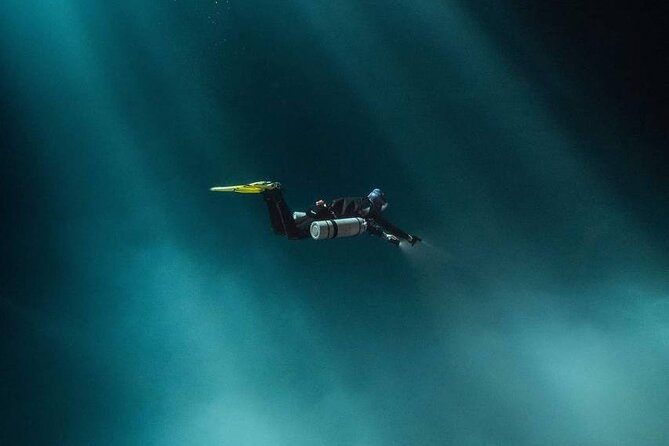
As we delve further into the wonders of cenotes, let’s now explore the fascinating formation and geological features that make these natural sinkholes truly awe-inspiring. Cenotes are formed through a unique process that involves the collapse of limestone bedrock, revealing underground chambers filled with crystal-clear water. These underground chambers are often adorned with stunning cave formations, such as stalactites and stalagmites, which have been formed over thousands of years due to the slow dripping of water. Exploring these underwater caves is a thrilling experience for divers, as they get to witness the intricate beauty of these geological formations up close. The exploration of cenotes provides a unique opportunity to venture into the Mayan underworld and discover the secrets hidden beneath the surface of the Earth.
| Formation | Geological Features |
|---|---|
| Limestone bedrock collapse | Crystal-clear water |
| Stalactites | Stalagmites |
| Underwater caves | Intricate beauty |
| Mayan underworld | Secrets hidden beneath the surface |
Importance to the Mayan Culture
Immersed in the depths of the Mayan underworld, cenotes hold a profound significance to the ancient Mayan culture. These natural sinkholes weren’t only a vital source of freshwater for the Mayans, but they also played a crucial role in their religious and spiritual practices.
Cenotes were considered sacred places, believed to be portals to the realm of the gods. The Mayans believed that these underground caves connected them to the spiritual world, and they’d perform elaborate rituals and ceremonies in their depths. These rituals often involved offerings to the gods, such as precious objects or sacrifices.
The spiritual significance of cenotes in Mayan culture is a testament to the deep connection the Mayans felt with the natural world and their belief in the interconnectedness of all things.
Diving Equipment and Safety Precautions
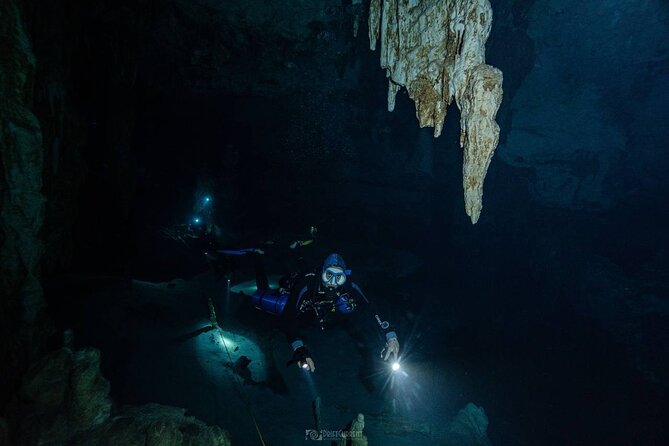
Venturing into the mystical depths of the Mayan underworld, divers must equip themselves with essential gear and adhere to stringent safety precautions.
Diving in cenotes requires specialized equipment to ensure a safe and enjoyable experience. Divers should have a reliable diving suit, fins, mask, and regulator. It’s crucial to have a backup air supply, such as a pony bottle or a spare regulator, in case of emergencies.
Plus, divers should be proficient in diving techniques, such as buoyancy control and underwater navigation, to navigate the cenote’s unique environment. Safety precautions include conducting thorough dive planning, maintaining proper communication with dive buddies, and always staying within the designated diving limits.
Underwater photography enthusiasts should also consider bringing a waterproof camera or housing to capture the breathtaking beauty of the cenotes.
Types of Cenotes for Diving
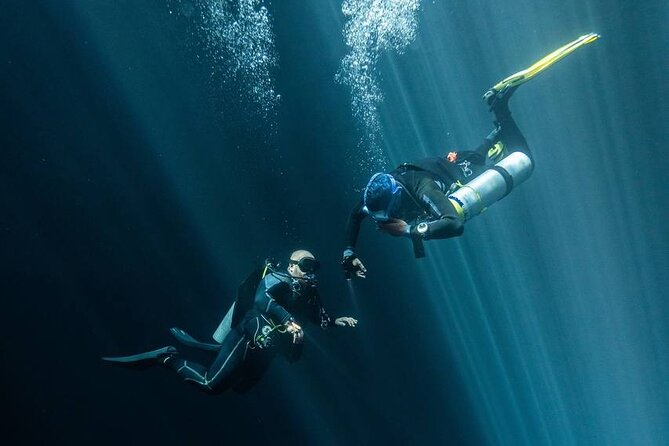
Divers exploring the Mayan underworld have a variety of cenotes to choose from, each offering its own unique diving experience. These underwater caves provide an opportunity to explore a world unlike any other. Here are five types of cenotes that divers can explore:
Open Cenotes: These cenotes have a large open pool of water, allowing divers to enjoy the sunlight filtering through the surface and illuminating the underwater world.
Semi-Open Cenotes: These cenotes are partially covered, with a small opening that allows sunlight to enter. Divers can experience a mix of natural light and darkness as they navigate through the passages.
Cave Cenotes: These cenotes are completely enclosed, offering an immersive experience in the darkness of the underwater caves. Divers can marvel at the stalagmites and stalactites that adorn the walls.
Cavern Cenotes: These cenotes have larger openings, allowing more natural light to enter. Divers can explore the caverns and witness the unique ecosystems that thrive in these environments.
Deep Cenotes: These cenotes have a depth that extends beyond the reach of sunlight. Diving in these cenotes offers a thrilling adventure into the depths of the Mayan underworld.
Each type of cenote provides divers with a different experience, showcasing the beauty and wonder of these unique ecosystems.
- Maroma Beach Jet Ski/Speedboat and ATV Adventure – Cancun
- Whale Shark Tour From Cancun, Playa Del Carmen, Tulum and Riviera Maya
- Small-Group Mesoamerican Barrier Reef Snorkeling in Puerto Morelos
- Luxury SUV From Cancun International Airport
- Hidden Cenote Swim & ATV Jungle Adventure With Transportation
- Horseback Riding and Cenote Swim From Cancun or Playa Del Carmen
Flora and Fauna in Cenotes
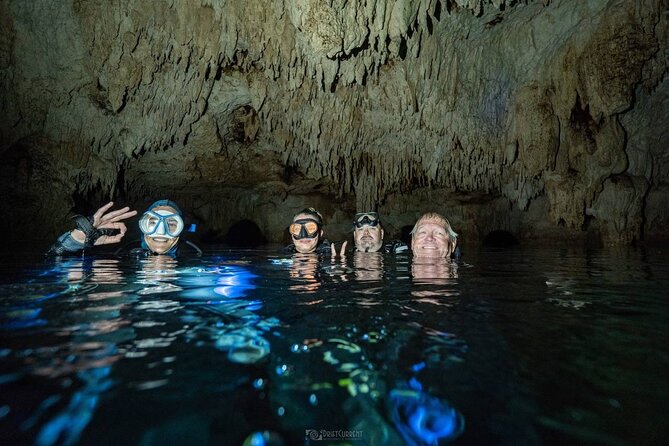
Exploring the depths of the cenotes reveals a vibrant and diverse ecosystem teeming with unique flora and fauna. These underwater caves aren’t only a wonder to behold, but they also serve as important habitats for a wide variety of species.
The cenotes’ unique ecosystems are characterized by crystal-clear waters, which allow sunlight to penetrate, providing ideal conditions for plant life to thrive. One can find submerged trees, vines, and aquatic plants, creating an ethereal underwater landscape.
As for fauna, divers may encounter species such as blind fish, catfish, and freshwater turtles. These creatures have adapted to the dark and cavernous environment, relying on their keen senses and unique adaptations to survive.
Indeed, the flora and fauna found in cenotes are a testament to the resilience and beauty of nature in the Mayan underworld.
Tips for an Unforgettable Cenote Dive
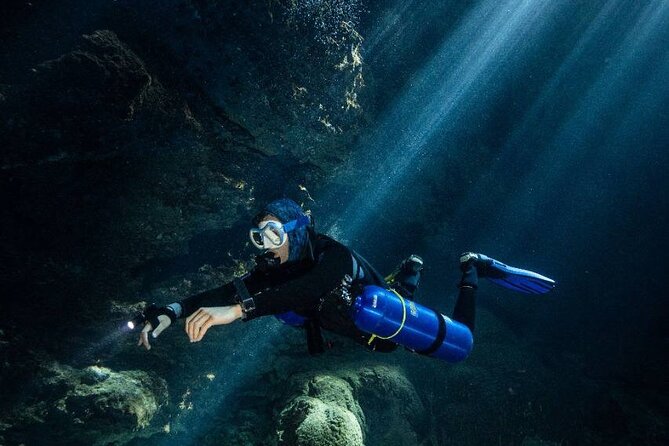
As divers descend into the depths of the cenotes, they can enhance their experience by following these tips for an unforgettable cenote dive:
Plan Ahead: Research the cenotes you plan to explore and choose ones that offer unique diving experiences. Each cenote has its own characteristics and underwater cave systems, so be sure to select ones that align with your interests and skill level.
Dive with a Guide: Exploring underwater caves can be challenging and potentially dangerous. It’s highly recommended to dive with an experienced guide who knows the cenotes well and can ensure your safety.
Bring the Right Gear: Make sure you have all the necessary equipment, including a reliable dive light, a compass, and a reel. These tools will help you navigate the dark and intricate cave passages.
Practice Good Buoyancy Control: Cenote diving often involves swimming through narrow passages and delicate formations. Practicing good buoyancy control will help you avoid damaging the environment and ensure a smoother and more enjoyable dive.
Respect the Environment: Cenotes are fragile ecosystems that need to be protected. Avoid touching or disturbing any formations, and always follow the guidelines set by the dive site and your guide. By being a responsible diver, you can help preserve these unique underwater landscapes for future generations.
Best Cenotes for Diving in the Mayan Riviera
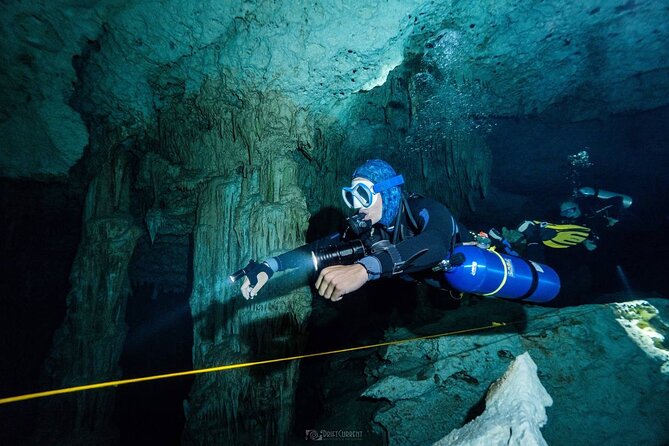
For an exhilarating diving experience in the Mayan Riviera, venture into the captivating cenotes that offer a unique and awe-inspiring underwater world.
The Mayan Riviera is home to numerous cenotes, each with its own distinct features and beauty. One of the best cenotes for diving is Dos Ojos, which means ‘two eyes’ in Spanish. This cenote is known for its crystal-clear waters and intricate cave formations, making it a favorite among divers.
Another popular choice is El Pit, a deep cenote with a natural sinkhole that offers a thrilling diving experience.
To explore these cenotes and many more, cenote diving tours are available for both beginners and experienced divers. For those looking to dive into the cenotes regularly, obtaining a cenote diving certification is recommended.
With its abundance of cenotes, the Mayan Riviera truly is a diver’s paradise.
Common Questions
How Do I Book a Diving Tour in the Cenotes?
To book a diving tour in the cenotes, simply follow the easy booking process. Choose from popular cenotes for diving and get ready for an adventure like no other. Don’t miss out on this exhilarating experience!
What Is the Cancellation Policy for Diving Tours in the Cenotes?
The cancellation policy for diving tours in the cenotes is non-refundable. Once booked, no changes are allowed. It is important to carefully consider before booking, as there will be no refunds in case of cancellation.
Are There Any Age Restrictions for Diving in the Cenotes?
Age restrictions and safety measures are in place for diving in the cenotes. These measures ensure that participants have the physical fitness level required and are of a certain age to safely explore the Mayan underworld.
Can I Bring My Own Diving Equipment or Is It Provided?
Yes, you can bring your own diving equipment or use the equipment provided. Whether you prefer to use your own gear or try out the provided equipment, you’ll have everything you need for an unforgettable diving experience.
Are There Any Restrictions on Underwater Photography in the Cenotes?
Underwater photography guidelines and safety precautions for diving in cenotes vary depending on the specific tour. It is recommended to check with the tour provider for any restrictions or guidelines regarding capturing photos underwater.
The Sum Up
To sum it up, diving in cenotes is a thrilling and awe-inspiring experience that offers a unique glimpse into the Mayan underworld.
With its rich history, stunning geological formations, and abundant marine life, cenotes provide a captivating adventure for both experienced divers and curious explorers.
By embracing safety precautions and preserving these delicate ecosystems, we can continue to explore the secrets of these hidden underwater worlds and appreciate the cultural significance they hold.
So, get ready to dive in and uncover the wonders of the Mayan underworld!
More Diving Tours in Cancun
More Tour Reviews in Cancun
Looking for something different? Other Cancun activities we've written about
- Cancun Private Driver
- Half Day Cenotes Tour
- Unforgettable Tour Holbox 2 Islands & Cenote Yalahau from Cancún
- Tulum & Dolphin Connection from Cancun
- 3 adrenaline activities Atvs Zipline and a swim experience in a cenote
- 4 activities in 1 Horse Riding, ATV Shared, Cenote & Ziplines from Cancún
- 3 Islands Snorkel on boat, Isla Blanca, Contoy, Mujeres
- Yacht experience in Cancun: cruise, swim and sunset views
- Chichén Itzá, Cenote Suytún & Cenote Ik-kil Expedition
- Casa Tortugas cenotes, Tulum Mayan site and Madre Naturaleza tour
- Hands-On Cooking Class in Cancun: Drink & Cook Authentic Dishes
- Basic Mayan Tour – Tulum Ruins, Coba, Cenote from Cancun
